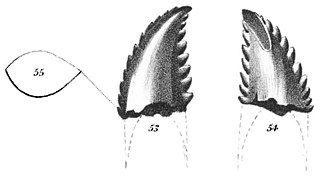
Troodon is a former wastebasket taxon and a potentially dubious genus of relatively small, bird-like dinosaurs known definitively from the Campanian age of the Late Cretaceous period. It includes at least one species, Troodon formosus, known from Montana. Discovered in October 1855, T. formosus was among the first dinosaurs found in North America, although it was thought to be a lizard until 1877. Several well-known troodontid specimens from the Dinosaur Park Formation in Alberta were once believed to be members of this genus. However, recent analyses in 2017 have found the genus to be undiagnostic and referred some of these specimens to the genus Stenonychosaurus and others to the genus Latenivenatrix.

Dromaeosaurus is a genus of dromaeosaurid theropod dinosaur which lived during the Late Cretaceous period, sometime between 80 and 69 million years ago, in Alberta, Canada and the western United States. The type species is Dromaeosaurus albertensis, which was described by William Diller Matthew and Barnum Brown in 1922. Its fossils were unearthed in the Dinosaur Park Formation. Teeth attributed to this genus have been found in the Prince Creek Formation. Dromaeosaurus is the type genus of both Dromaeosauridae and Dromaeosaurinae, which include many genera with similar characteristics to Dromaeosaurus such as possibly its closest relative Dakotaraptor. Dromaeosaurus was heavily built, more so than other dromaeosaurs that are similar in size, like Velociraptor.
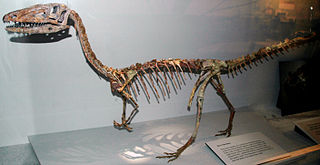
Coelophysis is an extinct genus of coelophysid theropod dinosaur that lived approximately 221.5 to 196 million years ago during the latter part of the Triassic Period in what is now the southwestern United States and a species possibly belonging to this genus, C. rhodesiensis, has been found in South Africa and Zimbabwe.

Procompsognathus is an extinct genus of coelophysid theropod dinosaur that lived approximately 210 million years ago during the later part of the Triassic Period, in what is now Germany. Procompsognathus was a small-sized, lightly built, ground-dwelling, bipedal carnivore, that could grow up to 1 m (3.3 ft) long.

Saltriovenator is a genus of ceratosaurian dinosaur that lived during the Sinemurian stage of the Early Jurassic in what is now Italy. The type and only species is Saltriovenator zanellai; in the past, the species had been known under the informal name "saltriosaur". Although a full skeleton has not yet been discovered, Saltriovenator is thought to have been a large, bipedal carnivore similar to Ceratosaurus.
Ozraptor is a genus of possibly abelisauroid theropod dinosaur from the Middle Jurassic (Bajocian) Colalura Sandstone of Australia, known from fragmentary remains.

Coelophysidae is a family of primitive carnivorous theropod dinosaurs. Most species were relatively small in size. The family flourished in the Late Triassic and Early Jurassic periods, and has been found on numerous continents. Many members of Coelophysidae are characterized by long, slender skulls and light skeletons built for speed. One member, Coelophysis, displays the earliest known furcula in a dinosaur.

Camposaurus is a coelophysid dinosaur genus from the Norian stage of the Late Triassic period of North America. The pertinent fossil remains date back to the early to middle Norian stage, and is widely regarded as the oldest known neotheropod.
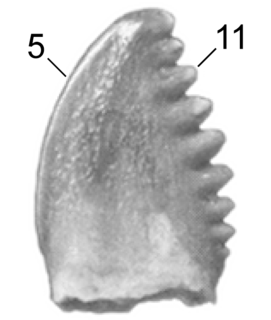
Pectinodon is a genus of troodontid dinosaurs from the Late Cretaceous period (66 mya). It currently contains a single valid species, Pectinodon bakkeri, known only from teeth.
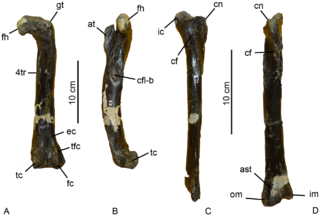
Aniksosaurus is a genus of dinosaur from what is now Chubut Province, Argentina. It was a theropod, specifically a coelurosaur, which lived in the Cenomanian to Turonian of the Cretaceous period, between 96-91 million years ago. The type species, Aniksosaurus darwini, was formally described from the Bajo Barreal Formation of the Golfo San Jorge Basin by Rubén Dario Martínez and Fernando Emilio Novas in 2006; the name was first coined in 1995 and reported in the literature in 1997. The specific epithet honors Charles Darwin who visited Patagonia in 1832/1833 during the Voyage of the Beagle.

Dracovenator is a genus of neotheropod dinosaur that lived approximately 201 to 199 million years ago during the early part of the Jurassic Period in what is now South Africa. Dracovenator was a medium-sized, moderately-built, ground-dwelling, bipedal carnivore, that could grow up to an estimated 7 m (23.0 ft) long. Its type specimen was based on only a partial skull that was recovered.
Kayentavenator is a genus of small carnivorous tetanuran dinosaur that lived during the Early Jurassic Period; fossils were recovered from the Kayenta Formation of northeastern Arizona and were described in 2010.

Albertadromeus is an extinct genus of orodromine thescelosaurid dinosaur known from the upper part of the Late Cretaceous Oldman Formation of Alberta, Canada. It contains a single species, Albertadromeus syntarsus.

Megapnosaurus is an extinct genus of coelophysid theropod dinosaur that lived approximately 188 million years ago during the early part of the Jurassic Period in what is now Africa. The species was a small to medium-sized, lightly built, ground-dwelling, bipedal carnivore, that could grow up to 3 m (9.8 ft) long. It was originally given the genus name Syntarsus, but that name was later determined to be preoccupied by a beetle. The species was subsequently given a new genus name, Megapnosaurus, by Ivie, Ślipiński & Węgrzynowicz in 2001. Many subsequent studies have classified it as a species within the genus Coelophysis.
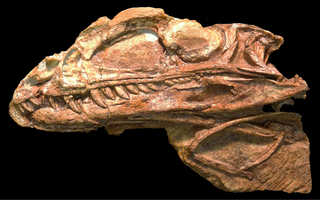
Coelophysis? kayentakatae is an extinct species of coelophysid dinosaur that lived approximately 200 - 196 million years ago during the early part of the Jurassic Period in what is now the southwestern United States. While originally assigned to the genus Syntarsus as Syntarsus kayentakatae, that genus name was found to be preoccupied by a Colydiine beetle, so it was moved to the genus Megapnosaurus as Megapnosaurus kayentakatae. Later it was moved again to Coelophysis, however the species still possesses no definite genus assignment.
Panguraptor is a genus of coelophysid theropod dinosaur known from fossils discovered in Lower Jurassic rocks of southern China. The type and only known species is Panguraptor lufengensis. The generic name refers to the deity Pangu but also to the supercontinent Pangaea for which in a geological context the same characters are used: 盘古. Raptor means "seizer", "robber" in Latin. The specific name is a reference to the Lufeng Formation. The holotype specimen was recovered on 12 October 2007 from the Lufeng Formation of Yunnan, which is noted for sauropodomorph fossils. It was described in 2014 by You Hai-Lu and colleagues.

This timeline of coelophysoid research is a chronological listing of events in the history of paleontology focused on the coelophysoids, a group of primitive theropod dinosaurs that were among Earth's dominant predators during the Late Triassic and Early Jurassic epochs. Although formally trained scientists didn't discover coelophysoid fossils until the late 19th century, Native Americans of the modern southwestern United States may have already encountered their fossils. Navajo creation mythology describes the early Earth as being inhabited by a variety of different kinds of monsters who hunted humans for food. These monsters were killed by storms and the heroic Monster Slayers, leaving behind their bones. As these tales were told in New Mexico not far from bonebeds of Coelophysis, this dinosaur's remains may have been among the fossil remains that inspired the story.
Shuangbaisaurus is genus of theropod dinosaur, possibly a junior synonym of Sinosaurus. It lived in the Early Jurassic of Yunnan Province, China, and is represented by a single species, S. anlongbaoensis, known from a partial skull. Like the theropods Dilophosaurus and Sinosaurus,Shuangbaisaurus bore a pair of thin, midline crests on its skull. Unusually, these crests extended backwards over the level of the eyes, which, along with the unusual orientation of the jugal bone, led the describers to name it as a new genus. However, Shuangbaisaurus also possesses a groove between its premaxilla and maxilla, a characteristic which has been used to characterize Sinosaurus as a genus. Among the two morphotypes present within the genus Sinosaurus, Shuangbaisaurus more closely resembles the morphotype that is variably treated as a distinct species, S. sinensis, in its relatively tall skull.

Lucianovenator is an extinct genus of coelophysid theropod dinosaur which lived in Argentina during the Triassic. The genus name Lucianovenator translates to "Luciano's hunter", in reference to Don Luciano Leyes, who first reported the remains. The species name bonoi refers to Tulio del Bono, a local scientific authority who collaborated on the describers' research. It is one of the few neotheropods known from South America.
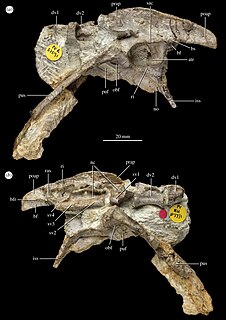
Pendraig is a genus of coelophysoid theropod dinosaur from South Wales. It contains one species, Pendraig milnerae, named after Angela Milner. The specimen was discovered in the Pant-y-Ffynnon quarry. In life it would have measured one meter in length.















